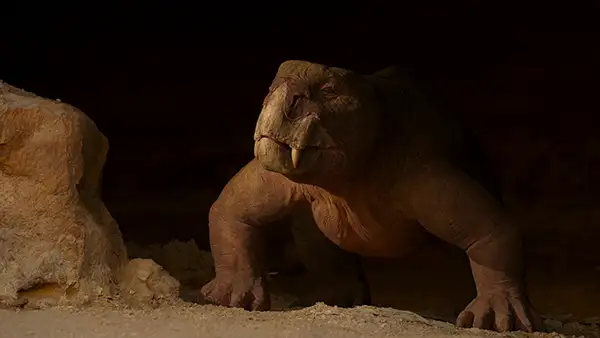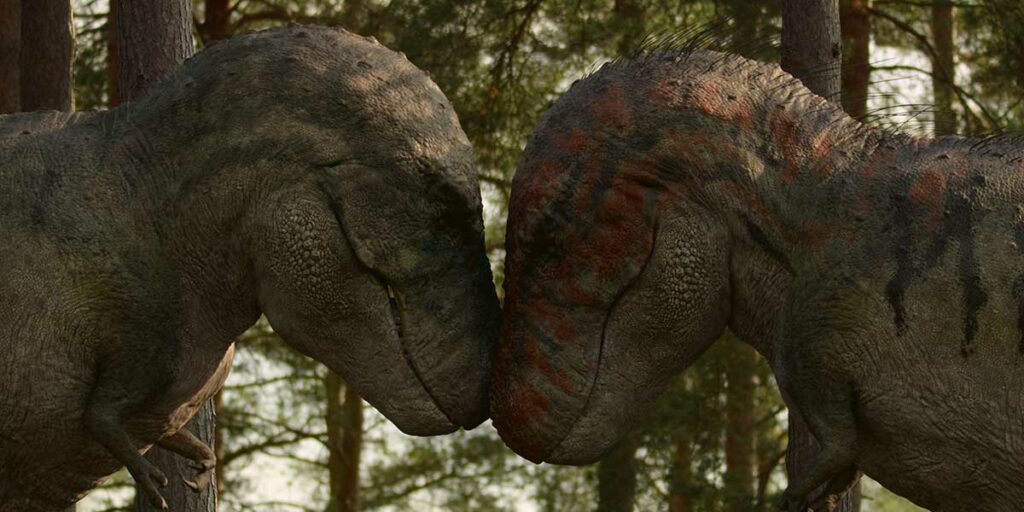Netflix’s Life on Our Planet is a crash course in Earth’s history; an informative if somewhat underwhelming recap of the story of life.
Prehistoric life is a fascinating topic for common man and scientist alike. Humans have only been on Earth for just over a million years; a mere blink of an eye in geologic time. What we discover through paleontology can be both inspiring and frightening, to think of how what we know about life is so small and reductive of human accomplishments. Through our searches, we can discover how massive and diverse life was, and even which threads from past geologic ages continue to the present day. This is what Netflix’s new documentary series Life on Our Planet seeks to contextualize.
Using the same formula and concept as their past nature documentary Our Planet, this show takes viewers on a journey from the earliest cell, LUCA (the Last Universal Common Ancestor), to the present day. Its journey is delivered through eight one-hour episodes, a breakneck pace considering the vast history of life on Earth, but the series makes the most of it. As a crash course of paleohistory, this series is one of the better all-encompassing examples. Most documentaries start with dinosaurs and ignore what came before, even though that part is just as interesting. Life on Our Planet includes these parts and its coverage of the more obscure sections of Earth’s history are its strongest points.
Our Earth is 4.6 billion years old, and in that time, the landscape and ecosystems have changed many times. Think of it like a popular video game that needs development patches or software upgrades to continue running. Continents shift with tectonic plates, temperatures rise and fall, and carbon emissions fluctuate with natural gas cycles. Through it all, new life finds ways to adapt, filling niches older organisms occupy. These are what delineates geologic time, and each era is broken into various periods. This series covers the periods of Earth’s history in rough chronological order, detailing just how many things have changed while also staying the same. The threads of life are all interconnected in one web, tracing back to the first strands of DNA. Seeing this unfold is seeing the story that led to our kind existing at all. This phenomenon of creation and destruction is unique on the scientific level, as the story which began billions of years ago continues to this day. This show does a good job at recapping what came before.
The further removed from humanity the show is, the more alien and unwelcoming the Earth becomes. The Paleozoic period covers the beginnings of life through the tremendous Permian extinction, which cleared away ninety percent of life. It is through its coverage of the Paleozoic that Life on Our Planet shines, as it showcases what many casual viewers may overlook in these documentaries. The Permian is an underrated period in Earth’s history. It shows the ancestors of the mammals and reptiles we see today in a grotesque, but still recognizable form, with a reshaped and hostile setting for their confrontations. They are not as recognizable as dinosaurs, but still fascinating in their own right, as they are just similar enough to the present day to be recognizable with their own ecology.

The series also makes the daring decision to include a gorgonopsid as the showcase animal for the time except for the more recognizable Dimetrodon, possibly to diminish the latter’s overexposure. By showing this unique time in our Earth’s history, Life on Our Planet can raise interest and further research into life before dinosaurs, showing how the story goes back even further than one might realize.
The visual effects of this series are outstanding, and the culmination of decades of effort in this genre. These CGI animals look fully realized and blend with the backgrounds convincingly. They are as real as the living animals which also litter the set pieces. While some dinosaur models are questionable and a bit cartoonish, most are up to date and able to look impressive as standalone models. The animators went above and beyond in fleshing out their characters, and they all look beautiful. Even for the short time they are on screen, each creature is given a personality and some degree of development.
Life on Our Planet is unique among these sorts of documentaries as it presents themes of the ephemerality of life, with each time period covered bookmarked by a mass extinction. There have been five in the course of Earth’s history, each one brought about for a different reason and having different effects. With each extinction, three-quarters of life is destroyed in an instant, which should give all viewers pause. The most dominant creatures of their time are often the first to go in these extinction waves. With such surprises and dramatic changes in who fills the dominant spot, it makes the planet both hostile and welcoming as a home for such diverse forms of life.
The first episode is jarring and rushed in pacing. It seems like the producers felt they had to include the main attractions of dinosaurs and mammoths to hold interest otherwise there would be no viewers. It summarizes everything at a breakneck pace of forty minutes, with many clips presented in a strange order while cramming in as much detail as possible. This one episode feels superfluous, especially since the rest follows a specific order, and can be skipped to avoid messing with the chronology of the show. Thankfully, the rest of the series follows a different pace and devotes more time to telling its stories. Once viewers get past the first episode, the rest does improve.
Life on Our Planet is not all CGI, however. Real world footage of the modern natural world is used to contextualize ideas presented in the CGI segments. For example, komodo dragons hunting their prey follow the Permian footage of the gorgonopsid hunting, to show the inspiration given to the animators for creating the scene. The dinosaur Anchiornis taking flight is underscored by film of a flamingo, to illustrate progress in the art of powered flight across 66 million years. In the wrong hands, this could have been jarring and made Life on Our Planet just another nature show in disguise. But the way they are presented here emphasizes the themes of the series and helps viewers understand nature even better. A major theme of Life on Our Planet is that examining any point in the study of nature and ecology will take you back to the beginning of time, so the natural footage shows which parts are topical to the current segment.
While the Paleozoic periods are the series’ strongest, the show falls apart once it hits the Mesozoic. The inaccurate description of a pliosaur as a “plesiosaur” may be the first red flag for accuracy. Not to mention how both pliosaurs and turtles are erroneously placed in the Triassic Period, before even the mention of the first dinosaur. Mammoth hunting is shown in an exaggerated way, with cave lions overpowering a mammoth in comical fashion. Such fantastic creatures as dinosaurs and large mammals deserve better than quick flashes, with so many stories to be told about their history. Still, most of what is shown is up to date scientifically and a few segments like “Smilodon vs. Doedicurus” in Episode Seven can hold attention, being whimsical but still in line with what is known to science.
In its attempts to create narrative, Life on Our Planet stretches suspension of disbelief at times. Portraying the Lystrosaurus as helpless sheep lured to death by the rise of crocodilians is an oversimplification at best, and undermines the success story these creatures did accomplish in this time. Later on, the “terror birds” are underestimated in their capabilities. They are shown taking up the hunt, but then eaten by a Smilodon (saber-toothed cat) later, which weakens their impact. These CGI demonstrations of life on Earth are well-directed, but do not get enough time to breathe or form attachments to these creatures. The emphatic narration provided by Morgan Freeman is voiced well, but often leans so far into hyperbole and exaggeration it can be hard to take seriously. Still, this does not detract from the stories at play, though at times it may be better to have the visuals speak for themselves.
Also, the series’ focus on “dynasties” of life seems peculiar, when competition is often not the root cause of extinction. Animals are pitted against each other, such as mammals against dinosaurs, which implies the struggle for survival being among food chains. The show’s depictions of these conflicts seem to be an outdated understanding of ecology, as competition alone does not determine who survives in a changing world. The first episode outright asserts how Smilodon drove the terror bird to extinction by outcompeting with it for food, which modern paleontology does not support. Climate change and environmental factors are shown to be what leads to the greatest mass extinctions, but interspecies conflict is still the central focus, leading to a somewhat diluted message.
Life on Our Planet succeeds as a teaching tool, despite falling short in spectacle and engagement. Paleontology enthusiasts will find it easy to nitpick, and its narrative structure is flawed, but newcomers and casual dinosaur lovers will find much to enjoy. Its visual effects and cinematography alone are enough to give it a recommendation, but it only provides a cursory exploration of prehistoric life, leaving a desire for something more enriching. Mixed messages and hit or miss vignettes of prehistoric life make for an uneven watch, but when the series gets a point right, it excels. Overall, a satisfying watch, but best used as an introduction to the subject rather than a full academic offering.
Life on Our Planet is now available to watch on Netflix.

